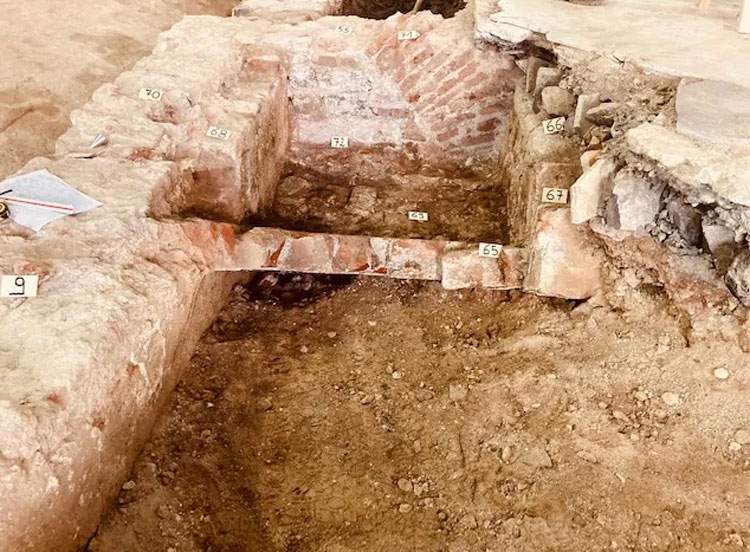Important archaeological discovery in the heart of Genoa’s historic center, where, under the floor of the Loggia dei Banchi, one of the city’s symbolic buildings (this is the ancient loggia where bargaining among merchants took place, and in the 19th century it housed the Genoa Commodities and Securities Exchange, while today it is an exhibition center), remains of the urban fabric of late medieval Genoa have been found. The discovery was made as part of the construction site for the City Museum.
The first archaeological interventions date back to last April: even then a large cistern with a brick vault, chronologically coeval with the construction of the loggia in 1595, had been unearthed. At a later stage, however, the needs of the construction site and some design expedients led to the widening of the investigations over a larger area, and thus an important multi-layered archaeological complex emerged, sealed by the construction of the Loggia dei Banchi, which constitutes an unprecedented and recognizable cross-section of the late medieval city. In particular, a residential building, facing the ancient roadway and softened by an ashlar loggia, can be recognized in the complex, and within it vaulted rooms pertaining to the fondaco warehouses have been identified. These buildings were most likely the property of the Usodimare consorteria, an ancient family of Genoese merchants, navigators and shipowners who, as early as the 12th century, occupied the upper echelons of the city’s administration with some people holding the consulate.
Breaking the news of the find was the City of Genoa. The findings give an account of a fundamental moment in Genoa’s urban evolution, not least because they affect one of the nerve centers of the ancient city, located at the meeting point between the areas of San Luca, Soziglia, San Lorenzo (Duomo) and the Old Port (and thus the sea). The square on which the Loggia stands, Piazza Banchi, in the 15th century was still bordered by the properties of the Albergo degli Usodimare, which then gradually, beginning in the early 16th century, was transformed into covered public spaces for financial trading.
“The Museum of the City,” says Culture Councillor Barbara Grosso, “will rise on a site that, in light of archaeological findings, can become a symbol of our history, confirming Genoa’s distinctiveness as one of the most stratified cities in the world. Visitors to the new museum will take a journey through time, through centuries of history, through the lives lived by the families and merchants who have made Genoa the Superb since the Middle Ages. The well-preserved finds of a significant portion of the city hidden for centuries represent not only an important addition to local archaeological research but also an evocative element that enriches the attractiveness of the future museum center.”
“The discovery of such a significant and well-preserved portion of the late medieval city within the New Museum,” stresses the Superintendent of Archaeology Fine Arts and Landscape for the metropolitan city of Genoa and the province of La Spezia, Manuela Salvitti, “represents an exceptional confirmation of its strategic location, providing unpublished material and new design suggestions for the architects and archaeologists called upon to enhance and tell the story of our city.”
“Our Genoa,” comments Ilaria Cavo, Liguria Regional Councilor for Culture, “never ceases to amaze. It keeps everything hidden but eventually allows itself to be discovered. The finding is a confirmation of the central role played in the Middle Ages by the area of Piazza Banchi and confirms for us, as Superintendent Salvitti explained so well, the stratification of Genoa. A primacy of the city. A history that can now be told and shown in an extraordinarily effective way. Thanks are due to the professionalism with which the excavations were conducted, as part of the construction site initiated and desired by the City of Genoa for the design of the City Museum, and for the foresight with which the Superintendency was able to grasp, from the very beginning, the importance and the opportunity of an in-depth archaeological study in view of the construction of the City Museum. After what has happened, the report of the archaeologists will be fundamental in understanding how to proceed and thus make the most of the cross-section of the medieval city that has resurfaced.”
 |
| Major archaeological discovery in Genoa: medieval complex resurfaces in the heart of downtown |
Warning: the translation into English of the original Italian article was created using automatic tools. We undertake to review all articles, but we do not guarantee the total absence of inaccuracies in the translation due to the program. You can find the original by clicking on the ITA button. If you find any mistake,please contact us.